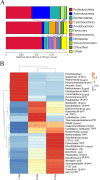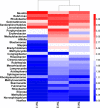Novel acsF Gene Primers Revealed a Diverse Phototrophic Bacterial Population, Including Gemmatimonadetes, in Lake Taihu (China)
- PMID: 27401973
- PMCID: PMC5007773
- DOI: 10.1128/AEM.01063-16
Novel acsF Gene Primers Revealed a Diverse Phototrophic Bacterial Population, Including Gemmatimonadetes, in Lake Taihu (China)
Abstract
Anoxygenic phototrophs represent an environmentally important and phylogenetically diverse group of organisms. They harvest light using bacteriochlorophyll-containing reaction centers. Recently, a novel phototrophic bacterium, Gemmatimonas phototrophica, belonging to a rarely studied phylum, Gemmatimonadetes, was isolated from a freshwater lake in the Gobi Desert. To obtain more information about the environmental distribution of phototrophic Gemmatimonadetes, we collected microbial samples from the water column, upper sediment, and deeper anoxic sediment of Lake Taihu, China. MiSeq sequencing of the 16S rRNA, pufM, and bchY genes was carried out to assess the diversity of local phototrophic communities. In addition, we designed new degenerate primers of aerobic cyclase gene acsF, which serves as a convenient marker for both phototrophic Gemmatimonadetes and phototrophic Proteobacteria Our results showed that most of the phototrophic species in Lake Taihu belong to Alpha- and Betaproteobacteria Sequences of green sulfur and green nonsulfur bacteria (phototrophic Chlorobi and Chloroflexi, respectively) were found in the sediment. Using the newly designed primers, we identified a diverse community of phototrophic Gemmatimonadetes forming 30 operational taxonomic units. These species represented 10.5 and 17.3% of the acsF reads in the upper semiaerobic sediment and anoxic sediment, whereas their abundance in the water column was <1%.
Importance: Photosynthesis is one of the most fundamental biological processes on Earth. Recently, the presence of photosynthetic reaction centers has been reported from a rarely studied bacterial phylum, Gemmatimonadetes, but almost nothing is known about the diversity and environmental distribution of these organisms. The newly designed acsF primers were used to identify phototrophic Gemmatimonadetes from planktonic and sediment samples collected in Lake Taihu, China. The Gemmatimonadetes sequences were found mostly in the upper sediments, documenting the preference of Gemmatimonadetes for semiaerobic conditions. Our results also show that the phototrophic Gemmatimonadetes present in Lake Taihu were relatively diverse, encompassing 30 operational taxonomic units.
Copyright © 2016, American Society for Microbiology. All Rights Reserved.
Figures






Similar articles
-
Planktonic and sedimentary bacterial diversity of Lake Sayram in summer.Microbiologyopen. 2015 Oct;4(5):814-25. doi: 10.1002/mbo3.281. Epub 2015 Aug 3. Microbiologyopen. 2015. PMID: 26242906 Free PMC article.
-
Sediment prokaryote communities in different sites of eutrophic Lake Taihu and their interactions with environmental factors.World J Microbiol Biotechnol. 2015 Jun;31(6):883-96. doi: 10.1007/s11274-015-1842-1. Epub 2015 Mar 13. World J Microbiol Biotechnol. 2015. PMID: 25772498
-
Pyrosequencing analysis of bacterial communities in Lake Bosten, a large brackish inland lake in the arid northwest of China.Can J Microbiol. 2016 Jun;62(6):455-63. doi: 10.1139/cjm-2015-0494. Epub 2016 Jan 18. Can J Microbiol. 2016. PMID: 27045804
-
Identification and characterization of ecologically significant prokaryotes in the sediment of freshwater lakes: molecular and cultivation studies.FEMS Microbiol Rev. 2000 Dec;24(5):573-90. doi: 10.1111/j.1574-6976.2000.tb00559.x. FEMS Microbiol Rev. 2000. PMID: 11077151 Review.
-
Aerobic anoxygenic phototrophic bacteria.Microbiol Mol Biol Rev. 1998 Sep;62(3):695-724. doi: 10.1128/MMBR.62.3.695-724.1998. Microbiol Mol Biol Rev. 1998. PMID: 9729607 Free PMC article. Review.
Cited by
-
Minimal transcriptional regulation of horizontally transferred photosynthesis genes in phototrophic bacterium Gemmatimonas phototrophica.mSystems. 2024 Sep 17;9(9):e0070624. doi: 10.1128/msystems.00706-24. Epub 2024 Aug 27. mSystems. 2024. PMID: 39189770 Free PMC article.
-
Determining lineage-specific bacterial growth curves with a novel approach based on amplicon reads normalization using internal standard (ARNIS).ISME J. 2018 Nov;12(11):2640-2654. doi: 10.1038/s41396-018-0213-y. Epub 2018 Jul 6. ISME J. 2018. PMID: 29980795 Free PMC article.
-
(Meta)Genomic Analysis Reveals Diverse Energy Conservation Strategies Employed by Globally Distributed Gemmatimonadota.mSystems. 2022 Aug 30;7(4):e0022822. doi: 10.1128/msystems.00228-22. Epub 2022 Aug 1. mSystems. 2022. PMID: 35913193 Free PMC article.
-
Phylum Gemmatimonadota and Its Role in the Environment.Microorganisms. 2022 Jan 12;10(1):151. doi: 10.3390/microorganisms10010151. Microorganisms. 2022. PMID: 35056600 Free PMC article. Review.
-
Common Presence of Phototrophic Gemmatimonadota in Temperate Freshwater Lakes.mSystems. 2021 Mar 16;6(2):e01241-20. doi: 10.1128/mSystems.01241-20. mSystems. 2021. PMID: 33727400 Free PMC article.
References
-
- Zeng Y, Selyanin V, Lukeš M, Dean J, Kaftan D, Feng F, Koblížek M. 2015. Characterization of the microaerophilic, bacteriochlorophyll a-containing bacterium Gemmatimonas phototrophica sp. nov., and emended descriptions of the genus Gemmatimonas and Gemmatimonas aurantiaca. Int J Syst Evol Microbiol 65:2410–2419. doi: 10.1099/ijs.0.000272. - DOI - PubMed
Publication types
MeSH terms
Substances
LinkOut - more resources
Full Text Sources
Other Literature Sources
Molecular Biology Databases

